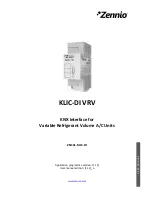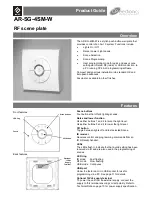
GND terminals 3, 7 and 13 are internally connected.
Terminal
Signal
Description
1
+10V
ref
Reference Output
Potentiometer Voltage, etc.
V
in
+
I
in
+
I
out
+
I
out
Analog Input Current
(range 0-20mA)
Analog Input Voltage
(range = 0-10V DC)
Frequency reference activated when
terminals 14
&
15 are open and
parameter 1.17 = 0 (default value)
3
4
I
in
5
GND
I/O Ground
Reference and Control GND
Frequency reference activated when
terminals 14
&
15 are closed or
If parameter 1.17 = 1, when terminals
14
&
15 are open.
6
+24V
Control Voltage Output¿
Switch Voltage, etc. (0.1A max.)
7
GND
I/O Ground
Reference and Control Ground
8
DIA1
Start Forward
(programmable in STANDARD)
9
DIA2
10
DIA3
Start Reverse
(programmable in STANDARD)
Start Reverse
(programmable in STANDARD)
Contact Closed = Start Reverse
Contact Closed = Start Forward
Contact Open = No Fault
Contact Closed = Fault
11
CMA
D1A1-D1A3 Common
Control Voltage Output
+24V
GND
DIB4
DIB5
Multi-Step Speed Select 1
Multi-Step Speed Select 2
I/O Ground
Connect to GND or +24V
12
Switch Voltage, etc. (0.1A max.)
13
Reference and Control Ground
Contact Open = No Action
Contact Closed = Fault Reset
14
15
open
closed
open
closed
D1B4
D1B5
Freq. Ref
open
open
closed
closed
Ref. V
in
(parameter 1.17=0)
Multi-Step Ref. 1
Multi-Step Ref. 2
Ref. I
in
(Terms. 4
&
5)
16
DIB6
Fault Reset
17
CMB
Common
Connect to GND or +24V
18
Output Frequency
Analog Output
Programmable in STANDARD (parameter 3.1)
(range 0-20mA/R
L
max. 500Ohm)
19
20
D01
Digital Output
READY
Programmable in STANDARD (parameter 3.6)
Open Collector (I
≤
50mA, V
≤
48V DC)
21
R01
Relay Output 1
RUN
Programmable in STANDARD (parameter 3.8)
Programmable in STANDARD (parameter 3.7)
22
R01
23
R01
24
R02
25
R02
26
R02
READY
FAULT
(50mA)
220V AC
Max.
2
Relay Output 2
FAULT
Connect CMA/CMB inputs to either logic high or logic low depending upon your application. Refer
to the SV9000 User Manual and SVReady Application Manual for additional information.
Reference Potentiometer
1-10 k
Ω
1
1
2
2
3
1
3
3
For the STANDARD Application, input signals at D1A1 and D1A2 are programmed as a pair using parameter 2.1.
2
1
Use the
LEFT
and
RIGHT MENU
buttons to enter the desired menu, then the
UP
and
DOWN BROWSER
button to access the desired
item.
QUICK REFERENCE GUIDE
Shipped from the factory, the SV9000 drive has (7) SVReady
Applications, with the drive’s default set to
BASIC Application
. This
guide is based on the use of the
BASIC
or
STANDARD
Application
outlined in the User Manual and SVReady Application Manual.
For the
BASIC Application
–
Control I/O signals are fixed and not programmable.
For the
STANDARD Application
–
DIA1-DIA3, Control I/O signals as well as output signals R01-R02 are
programmable.
Other applications have different terminal block assignments and
different parameter numbers or functions. These may be selected from
System Parameter Group 0, parameter P0.1. Refer to the SV9000 User
Manual for detailed information.
1
SVMulti-line™ CONTROL PANEL OPERATION
2
START-UP and I/O CONNECTIONS
• Go to menu screen M4.
• Press the
UP/DOWN BROWSER
button to go to application
screen B2.
• Press the
ENTER
button to switch from remote control to panel
control.
• Press the
START
button to start the drive.
• Go to menu screen M3.
• Press the
RIGHT MENU
button until R1 starts to blink.
• Press the
UP BROWSER
button to the desired motor frequency.
• Go to menu screen M1 and view the output motor frequency.
3
SCREEN DISPLAYS
Important:
This guide is intended to provide a quick reference to
the SV9000’s BASIC and STANDARD features for startup,
programming and service. It does not replace the need to thoroughly
read and understand the User Manual and SVReady™ Application
Manual.
RUN lights when the motor is running.
shows the selected motor rotation.
STOP lights when the motor is not running.
READY lights when input voltage is present and the drive is ready.
FAULT lights when a drive fault occurs.
PANEL/REMOTE shows the active control source.
LEFT MENU moves forward in the menu.
RIGHT MENU moves backward in the menu.
RESET resets drive faults.
START starts the motor when the panel is the
current control source.
STOP stops the motor when the panel is the
current control source.
ENTER acknowledges changed values,
resets fault history, and is pressed to enter program
settings.
DOWN BROWSER
UP BROWSER
ENTER
RESET
UP
DOWN
Moves in the main menu.
Moves between pages inside the same submenu.
Changes values.
STOP
START
M2
Parameter
G 1-12
M1
Monitor
V 1-20
M3
Reference
R1
M4
Buttons
B 1-4
M5
Active Faults
F 1-9
M6
Fault History
F 1-9
M7
Contrast
15
Fault History Reset
G2
Special Param.
G12
Scroll the Active Fault List
V2 Motor Speed
V3 Motor Current
V20 MotorTemp. Rise
G1
Basic Param.
P 1-15
R1
Freq. Reference
58.5 Hz
V1
Output Frequency
58.5 Hz
P1.1
Min. Frequency
12.34 Hz
P1.2
P12.x
P1.1
Min. Frequency
12.34 Hz
B2 Panel Control
B1
Reverse
1
B1
Reverse
0
R1
Freq. Reference
58.5 Hz
F1
1. Overcurrent
H1
2. Overvoltage
C1
Contrast
15
MENU SCREENS
SUB-MENU SCREENS
UP
DOWN
UP
DOWN
UP
DOWN
UP
DOWN
UP
DOWN
UP
DOWN
UP
DOWN
UP
DOWN
UP
DOWN
UP
DOWN
UP
DOWN
UP
DOWN
UP
DOWN
UP
DOWN
UP
DOWN
ENTER
ENTER
ENTER
Shipped from the factory the SV9000 is set to run forward from a contact closure at input DIA1, and to run in reverse from a contact closure at input
DIA2. To Run from a Keypad Setting –
























